You can buy these large charcole things that you can hook in line with your pipe (3/4 inch) that will take out the chlorine. You can either do whole house or if you have a faucet dedicated for the fishes just that faucet. Of course eventually the charcole will wear out and you will have to replace it - so you need to test it once a year or so depending where you put it and the size. They aren't super cheap but long run probably cheaper than treating the water. The real hang up is determing when the charcole wears out - what i did is put two of them serially so i can test the water from the first one once every few years and know that hte 2nd one will still catch the cholorine until i replace the first one.
Water Quality Issues
- Thread starter Trillium1000
- Start date
You are using an out of date browser. It may not display this or other websites correctly.
You should upgrade or use an alternative browser.
You should upgrade or use an alternative browser.
All said is true and I sincerely hope it helps you. I believe you become ticked off at mu earlier post, which I regret.
However, the most pressing issue in the tank in question is (it) being a severely overstocked small tank, and insufficient water change volume being performed regularly. There is no better or nicer way to say that, unless one lies to you.
As an example, just the 10 discus, or just the angels by themselves are more reasonable stocking levels for a 75g. Altogether, it is just to much, particularly under insufficient water changes.
When in a small tank, and with the other stock present, fish like discus will always be stressed and outcompeted (for food, for space, for areas to establish their territories) by the more assertive geos and angels, and by their own intra-specific aggression. Discus like to behave as shoals (with their hierarchies), usually around physical items inside the tank. That is not possible under current circumstances. The result - Chronic sub-optimal conditions that almost always result in they succumbing to issues that they would otherwise have partial resistance to, and eventually die. That is what you are experiencing.
The low ammonia in tap water does not help matters, but it by itself is probably not the main issue. A healthy filter, or presence of a healthy and abundant plant population would take care of that almost immediately, with few repercussions (provided it is not much ammonia). An RO unit (or treating water outside) will help with the ammonia in the tap water, but will not help with the other, more pressing issues. An FX6 is a nice filter (I use several myself in my tanks), but will not solve the space or overcrowding. Sorry, but it needs to be stated if one really wants to help you overcome the current situation. Good luck!
Hello,
Actually, I wasn't ticked off, it just didn't add up. I'm doing 30-50% water changes once a week and honestly, that was the problem. I'm putting in water that has been treated with a concentrated conditioner to remove chlorine, chloramines and ammonia from tap water, and detoxifies nitrite and nitrate, however it wasn't doing ENOUGH. Something wasn't getting out of it. That's what I'm asking about. The number of fish in my tank is not the issue. The folks who advise me at my aquarium store (not PetSmart) worked at the National Aquarium and have been doing this professionally for years. They were laughing when I told them my tank is overstocked.
You say they can't shoal, but you didn't even see my tank. You saw a close up. I'll attach a photo so you can see the entire tank including the plants. The geos are definitely more active and aggressive for food but they hang at the bottom and stir up the sand leaving the discus alone. I watch every feeding and who eats what and how much.
I have high ammonia in my tap water, not "low ammonia" like you said. It's a big problem and I believe it is the main issue. As of today I've replaced 20 gallons with RO water and we will see how it goes.
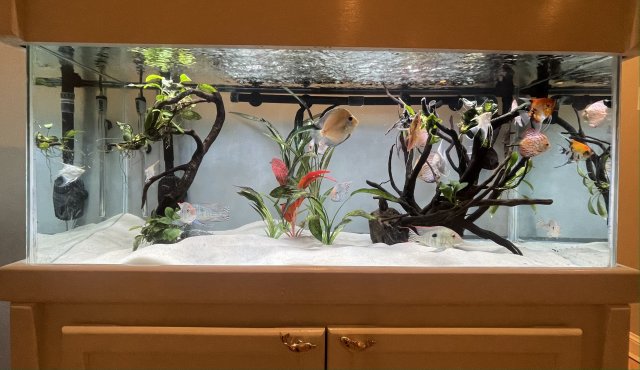
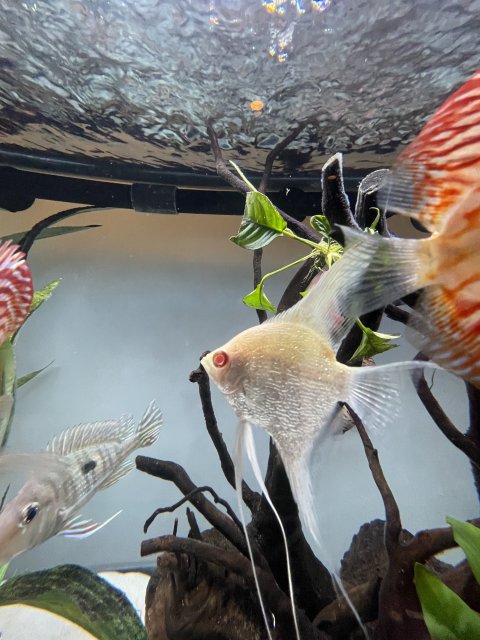
Thanks, VERY intriguing. I'll look into it! What I don't know about are the other bad things in the water, namely ammonia...You can buy these large charcole things that you can hook in line with your pipe (3/4 inch) that will take out the chlorine. You can either do whole house or if you have a faucet dedicated for the fishes just that faucet. Of course eventually the charcole will wear out and you will have to replace it - so you need to test it once a year or so depending where you put it and the size. They aren't super cheap but long run probably cheaper than treating the water. The real hang up is determing when the charcole wears out - what i did is put two of them serially so i can test the water from the first one once every few years and know that hte 2nd one will still catch the cholorine until i replace the first one.
A few things.
First, you reported very few accurate parameter readings for either your tap or tank. I saw 82F for water temp and 0-2ppm for ammonia in the tap. But what are the tank parameters and the rest of those for the tapas well: pH, GH, KH.
I keep true altum angels. To my knowledge there are not albino altums. What you have are albino Peruvian "altum" which is not a Pterophyllum altum it is a Pterophyllum scalare.
I have also had a 3 stage RO/DI unit form a number of years. I am space constrained and I use a portable unit. I got it specifically to deal with wild altums angels. I also just replaced it with a 4 stage unit. I have excellent well water Over the 23 years I have kept fish it has had a pH between 7.0 and 7.4. But is also contains excess CO2 when it come from the tap. So, before it is out-gassed, the pH reads in the low 6s. Over the years the TDS has been as low as 55 ppm and as high as about 110 ppm. Think KH between 2° and 5° and GH between 3° and 6°. The numbers change depending on the frequency and quantity of rain and snow in any given season.
Here is where I bought my units and they are portable. I have a sink with the faucet adapted to allow a graden hose size connector to screw into it. My units come with a compatible connector. I put the output of it into a 20 Gal. Rubbermaid/ I store 20 gals. in 1 gal jugs. and another 24 gals in bigger containers. I batch the changing water in a Rubbermaid next to the tank and use the same monitor probes in the can to allow me to batch changing water at the parameters need for any given water change. I usually target a pH 6.0 and a TDS under 70 ppm for the tank and adjust the changing water to be where I need them for that.
My original 3 stage RO/DI cost me about $125 + shipping. Today is is a bit more. I just did my first run with the 4 stage unit (cost $159): sediment-->carbon-->RO-->DI. It makes pure water. I do not remineralize, I mix my changing water at 11/9 ratio RO|DI/Tap. In the winter months we also batch RO/Di for my brother to use in his humidifiers. He uses up to 3 gallons a day in the driest coldest months.
In order to monitor all of this I have a Bluelab Guardian monitor. I paid less than the current price. Mine is the most basic version and they come with wireless connectivity etc. If you want the features and will pay up for them: Bluelab Guardian

I also have a couple of digital TDS pens. You can get these pretty cheaply on Amazon. HM TDS-3

As for ammonia, we cannot simply assume that any level we see on a hobby test kit is necessarily dangerous. Most kits measure Total Ammonia (TA) which includes ammonia (NH3) and ammonium (NH4). The former is very toxic while the latter is much less so. How much TA is in each form depends upon the pH and temperature of the water, The higher these are, the more toxic the TA becomes.
I wrote 3 articles for another site similar to this one but way way more active. Here is the part about how to work with ammonia:
SOME IMPORTANT FACTS ABOUT AMMONIA
Ammonia in water exists in two forms. NH3, which is the familiar nasty gas we know. Fish exhale NH3. Rotting organic matter will also create ammonia. This stuff is highly toxic and will definitely be harming fish by the time it reaches a concentration of .05 ppm (Some fish and inverts need even lower levels to be safe). However, most of the ammonia in water exists in the form of ammonium which is NH4. This is way less harmful. But in sufficient concentrations and/or exposure times, it causes external burns. The typical test kits we use measure Total Ammonia (TA) which is the sum of both NH3 and NH4.
Knowing how dangerous any level of TA might be requires that one know not only how much total ammonia there is but also how much of that total is in each form? The answer depends upon two other water parameters- pH and temperature. The higher the pH and/or temperature, the more of the TA that is in the toxic NH3 form. To calculate how much of the toxic NH3 form of ammonia requires that you know what the pH and temperature of your tank water are. Once you know all three numbers (total ammonia, pH and temperature) there is a formula for calculating how much of the total ammonia is in the form of NH3. It is way more complicated to use than most of us can handle. Fortunately, there are charts and tables available for this calculation. There is also currently a handy dandy ammonia calculator you can find here: http://www.hamzasreef.com/Contents/Calculators/FreeAmmonia.php
1. Choose NH (NH3 + NH4)*
2. Enter in the total ammonia reading from your test, choose ppm.
3. For a fresh water tank, enter 0 for the salinity.
4. Enter your tank’s current pH.
5. Enter your tank temperature and choose F or C, whichever applies.
6. Click Calculate.
The number you want to know is the one for NH3.
[* If your kit measures ammonia as nitrogen aka –N, choose NH-N (NH3-N + NH4-N) in step 1. above.]
Also, the EPA has no standards for ammonia in drinking water. However, what usually causes it is the use of chlormaine as opposed to chlorine as the primary disinfectant. Chloriamine is made by combining chlorine and ammonia. When we use dechlor on chloramine, it causes it to rbreak down into the two components. The dechlor neutralizes the chlorine. Depending on which brand one uses, it may also detoxify ammonia. It does this by converting it to NH4. The bacteria can still use this but do so less efficiently that they use NH3.
The amount of ammonia created by breaking down chloramine in a cycled tank is usually so low that it gets consumed by the bacteria pretty fast. The bacteria multiply when there is more ammonia available than they need to thrive.
Lastly, one of the Ph.D. folks in the hobby whom I greatly respect says one should never feed beef heart to any fish. I have kept discus in the past and DD black angels as well. I never fed beefheart. My altums have never tasted it either. So you were correct to stop feeding it. I know some discus folks will say to feed it. I do not agree.
OK, circling back.
A few things- the ammonia calculator is amazing. My NH3 number was 0.0025. The DC standards for ammonia in drinking water is 4.0 ppm and under (!!) I found that surprising and gross. My plumber who had a liver transplant years ago said that when he drank the tap water it was creating major problems, so I suspect there is something ELSE besides ammonia that I'm dealing with.
My ph in the tank is stable around 6.3 after I add the water. Out of the tap it's 7.5.
I just keep coming back to something in the water. However after your post, the calculator, and when I test my tank for ammonia it's always been 0.0, I'm thinking it's something else..................... the quest continues. In the mean time - it's RO for me. I'll pay $17 a week for 20 gallons, or I can get what you have an 4 step filter, which sounds attractive. Thank you so much for your input.
NoodleCats
AC Members
I think that was a little rude to FJB, to basically laugh at his advice. Sorry, but his advice is valid. If your fish store is better enough to laugh at his advice, why can't they help you with your tap problem?
I didn't want to repeat his advice for sake of not being super repetitive in this post, but yes your tank is crowded. These are large and semi aggressive fish crammed in a 4 foot space (75 gallons measure out to 4 feet long by 18 inches deep) and hate to break it to you but none of your fish are even full grown. Whether they've stopped growing or still have ways to go, they aren't full sized. You will see at full size that a 75g is a small tank for that many fish.
Angelfish and discus are shoaling fish, meaning 6-8 minimum of each, and they get territorial during spawning. They need a 5 foot length of tank or more to accommodate both of these needs--alone. Not together. Either angel fish or discus. You'd need to go larger to keep both.
Cramming them together in a smaller tank increases stress, which makes them weaker to problems when and if they pop up--which you are seeing.
Yes, ammonia in your tap water is 100% a problem that needs to be worked out.
But so is crowding issues.
Both of these should be addressed and maybe instead of getting defensive and laugh with your pet store over what's being said to you, perhaps take a step back and think on it.
IF your angels are actually altums, they'll get even larger than regular scalare.
You can see easily how your fish are not full grown and are not going to live comfortably in a 75g longterm.
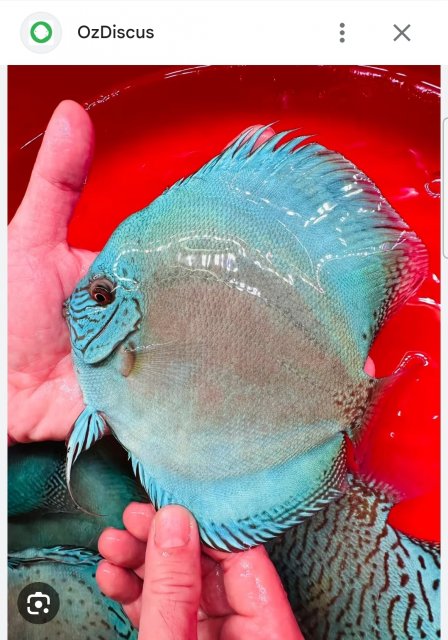
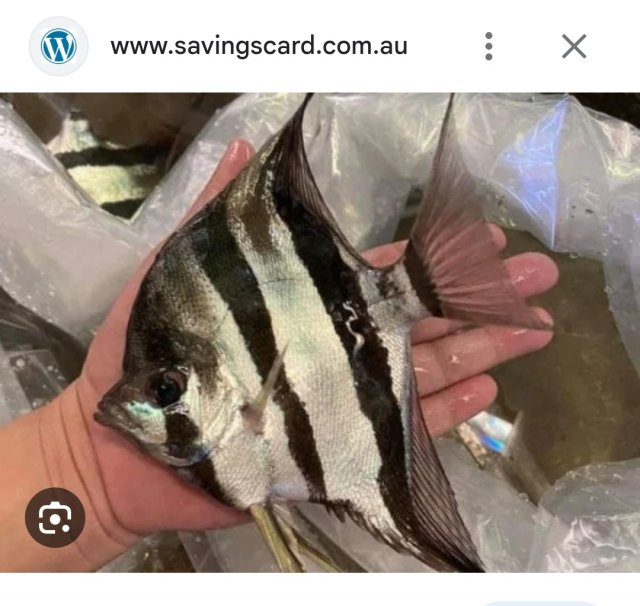
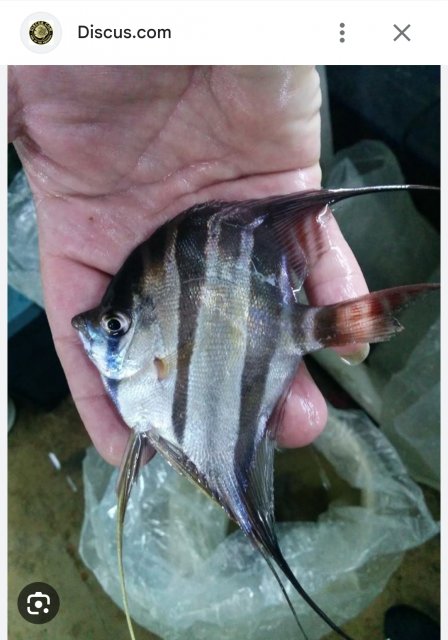
Sorry, but that was quite rude, FJB has solid advice here for you that's not only being ignored but being laughed at. It's one thing to just say thank you and not do it and just do as you want, but it's another to flat be arrogant and rude about it. I don't think he deserved that.
I didn't want to repeat his advice for sake of not being super repetitive in this post, but yes your tank is crowded. These are large and semi aggressive fish crammed in a 4 foot space (75 gallons measure out to 4 feet long by 18 inches deep) and hate to break it to you but none of your fish are even full grown. Whether they've stopped growing or still have ways to go, they aren't full sized. You will see at full size that a 75g is a small tank for that many fish.
Angelfish and discus are shoaling fish, meaning 6-8 minimum of each, and they get territorial during spawning. They need a 5 foot length of tank or more to accommodate both of these needs--alone. Not together. Either angel fish or discus. You'd need to go larger to keep both.
Cramming them together in a smaller tank increases stress, which makes them weaker to problems when and if they pop up--which you are seeing.
Yes, ammonia in your tap water is 100% a problem that needs to be worked out.
But so is crowding issues.
Both of these should be addressed and maybe instead of getting defensive and laugh with your pet store over what's being said to you, perhaps take a step back and think on it.
IF your angels are actually altums, they'll get even larger than regular scalare.
You can see easily how your fish are not full grown and are not going to live comfortably in a 75g longterm.



Sorry, but that was quite rude, FJB has solid advice here for you that's not only being ignored but being laughed at. It's one thing to just say thank you and not do it and just do as you want, but it's another to flat be arrogant and rude about it. I don't think he deserved that.
I think that was a little rude to FJB, to basically laugh at his advice. Sorry, but his advice is valid. If your fish store is better enough to laugh at his advice, why can't they help you with your tap problem?
I didn't want to repeat his advice for sake of not being super repetitive in this post, but yes your tank is crowded. These are large and semi aggressive fish crammed in a 4 foot space (75 gallons measure out to 4 feet long by 18 inches deep) and hate to break it to you but none of your fish are even full grown. Whether they've stopped growing or still have ways to go, they aren't full sized. You will see at full size that a 75g is a small tank for that many fish.
Angelfish and discus are shoaling fish, meaning 6-8 minimum of each, and they get territorial during spawning. They need a 5 foot length of tank or more to accommodate both of these needs--alone. Not together. Either angel fish or discus. You'd need to go larger to keep both.
Cramming them together in a smaller tank increases stress, which makes them weaker to problems when and if they pop up--which you are seeing.
Yes, ammonia in your tap water is 100% a problem that needs to be worked out.
But so is crowding issues.
Both of these should be addressed and maybe instead of getting defensive and laugh with your pet store over what's being said to you, perhaps take a step back and think on it.
IF your angels are actually altums, they'll get even larger than regular scalare.
You can see easily how your fish are not full grown and are not going to live comfortably in a 75g longterm.
View attachment 232551View attachment 232552View attachment 232553
Sorry, but that was quite rude, FJB has solid advice here for you that's not only being ignored but being laughed at. It's one thing to just say thank you and not do it and just do as you want, but it's another to flat be arrogant and rude about it. I don't think he deserved that.
You don't think he came on super strong in the first place? He made several conclusions based on very little facts. How is that rude to laugh at someone who is dosing out advice based on very little and also not reading most of my posts. Are you actually serious? As for the size of my fish, some of them are full grown and some are not. I'm fully aware of the size of my fish. I think it's quite aggressive of you to post this and assume I don't know that. The size of my tank is fine for the amount and size of my fish. You have a different opinion and that's fine. Thanks so much for giving it.
NoodleCats
AC Members
He stated it as politely as possible. You could have had the grace to say thank you and move on, but instead you insulted him and that's just not okay.
And yes, your tank is too small for the amount of large fish you have in it. I stand by that.
We can't help you with this mindset, but I wish you the best.
And yes, your tank is too small for the amount of large fish you have in it. I stand by that.
We can't help you with this mindset, but I wish you the best.
My 2 Cents.... RO will help with the water issues and ammonia, make sure you remineralize. I'd do the 20 gallons twice a week. I also think you tank is overstocked. I highly doubt you have any altum angels and the ones you have can grow larger. Same with the Discus. This is why I think its overstocked. Not say you can't keep all them in there, they just won't get to their full size and you'll continue to have issues. I think especially with the Discus. The tank looks great and looks really clean and clear. I'd get another tank... 55 Gallon and move the Geos into that one Or a 90 Gallon and move the discus into that one. Or get a 125 gallon (6 ft length) and keep them all together. Again my 2 cents. Good Luck.
Once the fishes (esp the angels) become sexual mature they will also become more aggressive with regards to territory. While individual angels are unpredictable with regards to level of aggressions; they can be super aggressive and will kill intruders if sufficiently aggressive. I've had females kill all other female (angels) in a 120. It happens. I"m not as familiar with discus level of aggression or altums so won't repeat what i've heard. I had to split my angles up in a 10x4 (feet) aquarium because one male was too territorial - he is now with his lass in an 8x4 to keep him from hounding my more passive pair. In a 75 you might get away with 4 or 6 angels but it depends how they mature - and you never know the true dynamics till around 18 months after birth as their aggression level changes a bit between when they first become sexually mature and when they are more or less full adults. Some become more passive others more aggressive.
there will always be some pecking between males for dominance but this is mostly harmless but the females can be extremely aggressive and territorial and this behavior is a bit different than pecking order aggression. She will kill and do it quite efficiently if she is sufficiently aggressive. The problem with these things is the behavior of individual fishes are quite variable and takes time to develop. So the fellow that plucks in 12 angels and post that everything is fine isn't nec. lying but will he come back in a year and tell you how it really worked out ?
there will always be some pecking between males for dominance but this is mostly harmless but the females can be extremely aggressive and territorial and this behavior is a bit different than pecking order aggression. She will kill and do it quite efficiently if she is sufficiently aggressive. The problem with these things is the behavior of individual fishes are quite variable and takes time to develop. So the fellow that plucks in 12 angels and post that everything is fine isn't nec. lying but will he come back in a year and tell you how it really worked out ?


